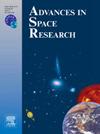Monthly mean sea level variability in the eastern sub-basin of the Gulf of Cadiz from altimetry and coastal tide gauge data sets
IF 2.8
3区 地球科学
Q2 ASTRONOMY & ASTROPHYSICS
引用次数: 0
Abstract
In this work, the main forcing factors affecting the monthly mean sea level in the eastern sub-basin of the Gulf of Cadiz (south-western Iberian Peninsula) are analysed in detail. Monthly mean sea level (MMSL) anomaly time series (30 years:1993–2022) from altimetry and tide gauges are used for this purpose. Validation of altimeter monthly MSL using two tide gauges (Huelva and Bonanza) gives high correlation coefficients (>0.85) and low RMSE (<3.5 cm). The comparison against Huelva was performed in the period: 1997–2022 due to data unavailability. A good level of accuracy is also observed for all the altimeter grid points analysed in the study area. The different local hydrodynamic conditions in the location of the tide gauges explains the differences in the validation results of altimeter data. The atmospheric pressure explains more than 40 % of the variance in the monthly mean sea level, indicating that this forcing factor is the main contributor to the sea level variability in our study area on long (>1 month) timescales. Taking into account the seasonal cycle, the variance ranges between 65 % (western sub-basin) and 74 % (eastern sub-basin). This percentage reaches up to 86–90 % of the variance considering the sea level trend. The isostatic assumption (−1 cm/hPa) is only valid on the western side of the sub-basin, reaching −1.3 cm/hPa on the eastern side with a marked E-W variation. For this reason, removing the atmospheric effect using inverse barometer correction can lead to misinterpretations of the contribution of this effect to the sea level variability. No significant differences were observed in the variability of the MMSL between coastal areas and the open ocean, while there was a slight spatial variation in the sea level trend, with minimum values in coastal areas close to the Strait of Gibraltar. Atmospheric pressure, although the main driver of MSL variability, does not affect the value of the sea level trend, but only reduces the uncertainty. This is also the case for the seasonal cycle.
加的斯湾东部次海盆的月平均海平面变率由测高和海岸潮汐计数据集得出
本文详细分析了影响加的斯湾东部次海盆(伊比利亚半岛西南部)月平均海平面的主要强迫因子。月平均海平面(MMSL)距平时间序列(30年:1993-2022)由测高仪和潮汐仪提供。使用两个潮汐计(Huelva和Bonanza)验证高度计月MSL得到高相关系数(>0.85)和低RMSE (<3.5 cm)。由于无法获得数据,与韦尔瓦的比较是在1997-2022年期间进行的。在研究区域分析的所有高度计网格点也观察到良好的精度水平。测潮仪所在位置的局部水动力条件不同,解释了高度计数据验证结果的差异。大气压力解释了月平均海平面变化的40%以上,表明这一强迫因子是我们研究区长(1个月)时间尺度海平面变化的主要贡献者。考虑季节循环,方差在65%(西部子盆地)和74%(东部子盆地)之间。考虑到海平面趋势,这一百分比高达86 - 90%的方差。均衡假设(- 1 cm/hPa)仅在子盆地西侧有效,东侧达到- 1.3 cm/hPa,东西向变化明显。因此,使用气压计逆校正去除大气效应可能导致对这种效应对海平面变率的贡献的误解。沿海地区和公海的MMSL变异性无显著差异,而海平面趋势存在轻微的空间差异,靠近直布罗陀海峡的沿海地区最小。大气压力虽然是MSL变率的主要驱动因素,但并不影响海平面趋势值,而只是降低了不确定性。季节周期也是如此。
本文章由计算机程序翻译,如有差异,请以英文原文为准。
求助全文
约1分钟内获得全文
求助全文
来源期刊

Advances in Space Research
地学天文-地球科学综合
CiteScore
5.20
自引率
11.50%
发文量
800
审稿时长
5.8 months
期刊介绍:
The COSPAR publication Advances in Space Research (ASR) is an open journal covering all areas of space research including: space studies of the Earth''s surface, meteorology, climate, the Earth-Moon system, planets and small bodies of the solar system, upper atmospheres, ionospheres and magnetospheres of the Earth and planets including reference atmospheres, space plasmas in the solar system, astrophysics from space, materials sciences in space, fundamental physics in space, space debris, space weather, Earth observations of space phenomena, etc.
NB: Please note that manuscripts related to life sciences as related to space are no more accepted for submission to Advances in Space Research. Such manuscripts should now be submitted to the new COSPAR Journal Life Sciences in Space Research (LSSR).
All submissions are reviewed by two scientists in the field. COSPAR is an interdisciplinary scientific organization concerned with the progress of space research on an international scale. Operating under the rules of ICSU, COSPAR ignores political considerations and considers all questions solely from the scientific viewpoint.
 求助内容:
求助内容: 应助结果提醒方式:
应助结果提醒方式:


